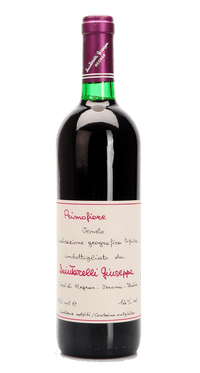
Tonight was a simple Monday meal: Rigatoni with Arugula Pesto.
I thought it might be a good idea to have something Italian, but something a little different to complement the oddball pesto (as opposed to the more traditional basil pesto). Giuseppe Quintarelli's 2002 Primofiore was at hand, and 10 years seems like a reasonable amount of time to drink a vino da tavola from anywhere, including this revered producer of Amarone. Beppe is considered the benchmark in Negrar for Amarone. Romano dal Forno was his protege and although his wines can be laden with volatile acidity and even high alcohol, his iconoclast style of releasing wines when he sees fit, as opposed to the demands of the market, have contributed to his legend. Beppe passed earlier this year, and the historical estate remains in the hands of his wife, son in law, and children. Unfortunately, the winery doesn't have a website and there a number of questions I can't answer with quick online searches, so I'll share some thoughts about the wine.
After less than an hour open, the wine is already all over the place in terms of components jumping out of the glass. It's curious, reminiscent of some Burgundy that piqued the wine geek to either lust for wistfully or become distraught over after it quickly fades. The Primofiore was immediately laced with acetic acid (red wine vinegar) in the nose. Then, a dark, brooding vegetal nose, not unlike some Pomerol or St. Emilion. Then, fig and dried fruit flavors one would expect from the most common grapes from the area: Corvina, Rondinella, and/or Molinara. There is cedar on the nose from some old oak, likely Slovenian given the cheaper cost and proximity to the Veneto. There is certainly more alcohol on the nose and in the mouth than the labeled 13.5%. I would guess it's closer to 14.5%, and this shouldn't be surprising since many of the grapes in the region are left to hang late into October and it's common to see the Valpo. Superiore and Amarone wines well above 15%.
The wine is labeled IGT, which means any grapes approved from the region are allowed and in any percentage to make the blend. Since Quintarelli makes a high end Cabernet Franc, it is likely some Cab. Franc is in the blend, as evidenced in the green bell pepper in the nose and mouth. The wine has a short finish but the bright acidity dances on the tongue, which makes this a fine medium-bodied wine to pair with a variety of foods. Leather and sweet tannins round out the palette. There is also an indication that this vino da tavola blend is bottled in separate lots because there is a L 187.04 number typed onto the standard label. The wine appears to be unfiltered. Although it is impressive as an IGT at ten years young, I'd say it's approaching the down hill curve of its life expectancy as the fruit is waning and the color fading to brickish red.
All in all, the wine is good. It's not great, but it's also the most accessibly priced of these hard to find wines. I'm not even sure which importer is now working with Quintarelli given that Robert Chadderdon is winding down his operation. Is it worth $40? Not if you're a value drinker. But, if you're curious about wine, this is a black box, intriguing and worth trying. With limited information available about the wine, after you try this wine, you might even be compelled to share your own notes.
Day 2 Notes: The wine still showing quite a bit of tannic grip and alcohol. Dried fruit flavors are waning giving rise to dried tarragon. VA still present. Cabernet Franc really coming through reminiscent of Bourgueil.
Leave a comment (all fields required)
Comments will be approved before showing up.



